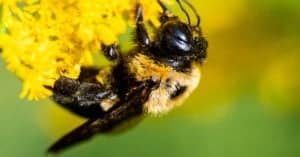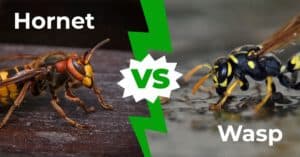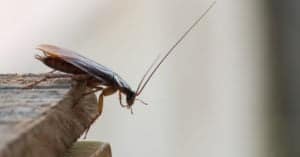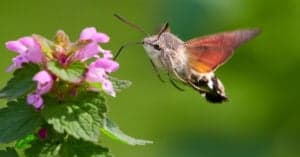What Do Hornworms Eat? They’re Nuts About Nightshades
The hornworm is a common name for a sphinx moth’s caterpillar (larvae). One species of hornworm is called the “tomato hornworm” because they love to munch on the leaves of tomato plants. Another species of hornworm prefers tobacco leaves. So what do hornworms eat besides tomato and tobacco plants? We’ve already given you a little clue – tomato and tobacco plants are part of a family of flowering plants called nightshades. There’s rarely a nightshade leaf or fruit the hornworm can resist.
Keep reading to learn more about specific plants that these big, blue-green caterpillars eat, how much hornworms eat, and how their diet might mess with your gardening goals. We’ll also look at how to feed hornworms in captivity.
What Do Hornworms Eat?
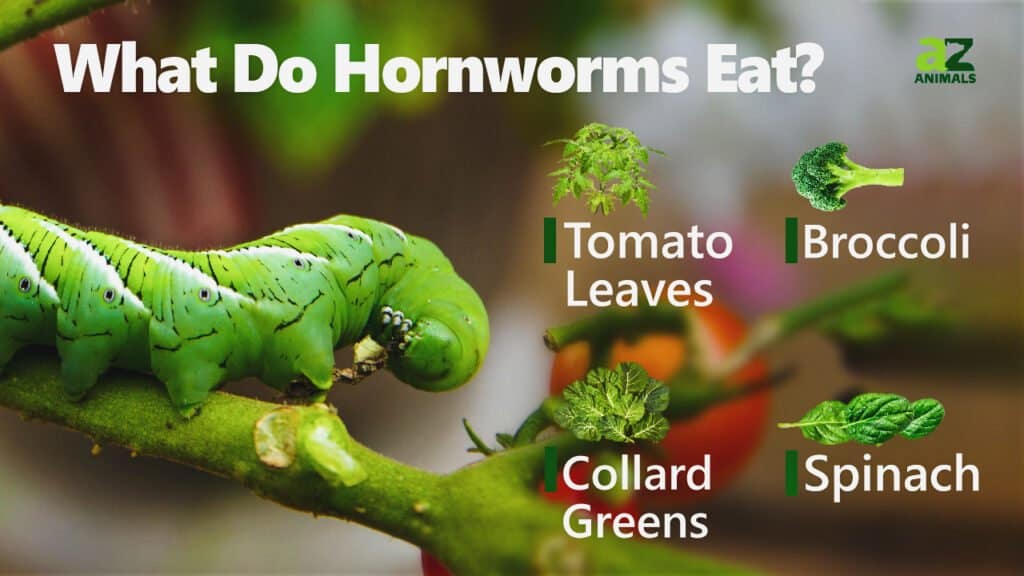
A-Z-Animals.com
Hornworms eat tomato leaves, tobacco leaves, nightshade vegetables, and weeds like horsenettle. Hornworms are herbivores and usually eat solanaceous plants (nightshades).
Whether living in the wild or captivity, the hornworm needs to eat every single day to survive. For this reason, hornworms usually lay their eggs under the leaves of their favorite plants.
Here’s a list of common foods the hornworm enjoys:
- Bell pepper
- Eggplant
- Horsenettle
- Jimsonweed
- Mulberry tree leaves
- Potato
- Silver nightshade
- Tomato leaves
- Tomatoes (green)
- Tobacco leaves
What Do Different Types of Hornworms Eat?
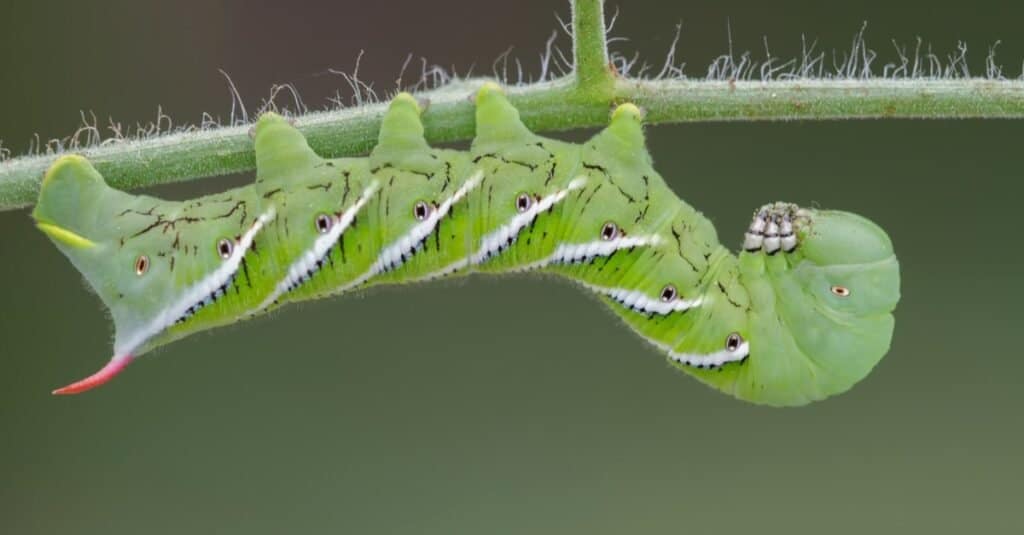
vbalson/Shutterstock.com
Manduca sexta is a hornworm species that eats mainly tobacco leaves. Manduca quinquemaculata is a hornworm species that prefer the leaves of tomato plants. These are the most common North American hornworms out of about 120 species living on this continent. There are around 1200 hornworm species total worldwide.
A fun fact about tobacco-loving hornworms is that their breath is so stinky from nicotine it can ward off predators. The nightshade plants that hornworms eat can make them toxic to some predators, as well.
How Much Do Hornworms Eat?
The hornworm stage of a sphinx moth’s life is all about growing, so they need constant nourishment. They grow into one of the 12 largest caterpillars in the world by eating up to four times their weight per day.
The average full-grown hornworm grows up to 4 inches long and weighs up to 4 grams. That means a hornworm could potentially eat up to 16 grams of food each day.
Their growing stage as caterpillars lasts only 2-3 weeks. Then hornworms drop from plants and burrow into the soil where they turn into pupae (a chrysalis). After another two weeks, the pupae has transformed into a brand new moth that rises up from the soil.
So all that transformation takes a lot of food to make it possible!
How Does the Hornworm Diet Impact Humans?

aaltair/Shutterstock.com
The plants that hornworms eat are also plants that humans grow and eat. Tomato farmers and tobacco farmers, in particular, can be negatively impacted by hornworms eating their crops. Even a small garden of nightshade plants, like eggplant and red bell peppers, could be wiped out quickly from an invasion of hungry hornworms.
There are some natural and non-toxic ways to help prevent hornworms from destroying a crop. Tilling before planting could kill hornworms that have overwintered in the soil. Planting companion plants that hornworms avoid – like basil plants paired with tomatoes – could discourage hornworms from feeding in that garden patch.
Natural hornworm predators might destroy these caterpillar populations for you. Braconid wasps love to use hornworms as host animals for their eggs. If you see a hornworm with tiny white eggs protruding from its body, the hornworm won’t last long as the wasp eggs feed on it. Lacewings and ladybugs also kill and eat hornworms every chance they get.
All that said, the sphinx moths (also called hawk moths) that hornworms eventually turn into are pollinators. We need pollinators to spread pollen around for new plant growth. Sphinx moths help pollinate plants by flying from flower to flower, drinking nectar through their pointy, elongated proboscis. The proboscis of a sphinx moth looks similar to that of a hummingbird’s beak.
How to Feed Hornworms in Captivity
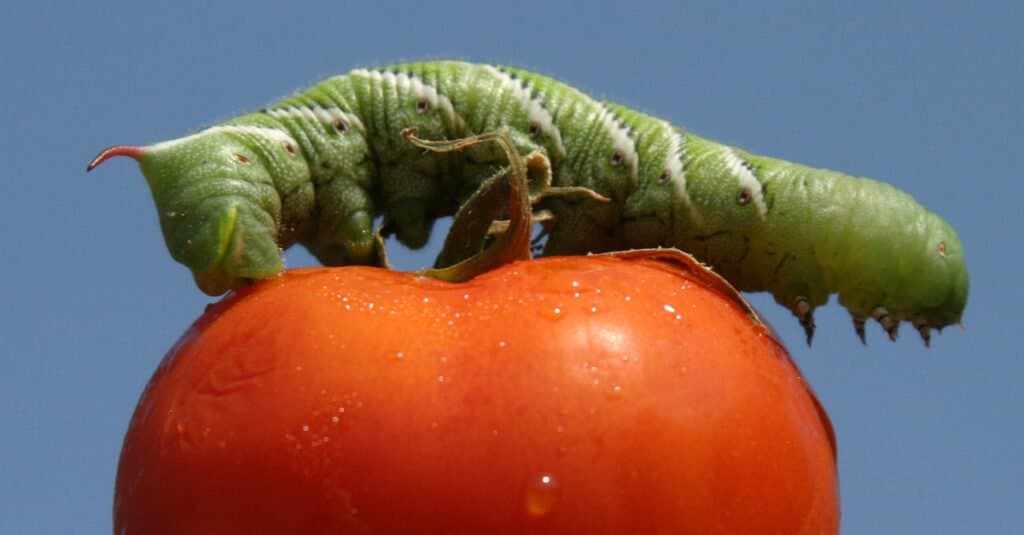
mikeledray/Shutterstock.com
If you’re raising hornworms to watch their metamorphosis into moths, feed them every day of the larvae (caterpillar) stage. Because you aren’t feeding them to other animals, your hornworms kept for this purpose can be fed as they would eat in the wild.
However, hornworms raised as mealworms to feed reptiles and amphibians like frogs, geckos, and bearded dragons need a special diet so that eating them doesn’t harm your pets. For example, hornworms that eat tomato leaves in the wild might be toxic to certain animals that can’t eat nightshades.
Commercial food for hornworms is available as a paste. These blends usually contain a mix of ingredients like agar, dandelion, grapevine leaves, yeast, linseed oil, and wheat germ. Your hornworms raised as food can also be fed a variety of leaves from your garden or grocery store, like collard, dandelion, mustard, and turnip greens.
Hornworms make ideal pet food for reptiles and amphibians in your care because they have soft exoskeletons that are easy to chew and digest.
More from A-Z Animals
The hornworm is a common name for a sphinx moth’s caterpillar (larvae). One species of hornworm is called the “tomato hornworm” because they love to munch on the leaves of tomato plants. Another species of hornworm prefers tobacco leaves. So what do hornworms eat besides tomato and tobacco plants? We’ve already given you a little clue – tomato and tobacco plants are part of a family of flowering plants called nightshades. There’s rarely a nightshade leaf or fruit the hornworm can resist.
Keep reading to learn more about specific plants that these big, blue-green caterpillars eat, how much hornworms eat, and how their diet might mess with your gardening goals. We’ll also look at how to feed hornworms in captivity.
What Do Hornworms Eat?

A-Z-Animals.com
Hornworms eat tomato leaves, tobacco leaves, nightshade vegetables, and weeds like horsenettle. Hornworms are herbivores and usually eat solanaceous plants (nightshades).
Whether living in the wild or captivity, the hornworm needs to eat every single day to survive. For this reason, hornworms usually lay their eggs under the leaves of their favorite plants.
Here’s a list of common foods the hornworm enjoys:
- Bell pepper
- Eggplant
- Horsenettle
- Jimsonweed
- Mulberry tree leaves
- Potato
- Silver nightshade
- Tomato leaves
- Tomatoes (green)
- Tobacco leaves
What Do Different Types of Hornworms Eat?

vbalson/Shutterstock.com
Manduca sexta is a hornworm species that eats mainly tobacco leaves. Manduca quinquemaculata is a hornworm species that prefer the leaves of tomato plants. These are the most common North American hornworms out of about 120 species living on this continent. There are around 1200 hornworm species total worldwide.
A fun fact about tobacco-loving hornworms is that their breath is so stinky from nicotine it can ward off predators. The nightshade plants that hornworms eat can make them toxic to some predators, as well.
How Much Do Hornworms Eat?
The hornworm stage of a sphinx moth’s life is all about growing, so they need constant nourishment. They grow into one of the 12 largest caterpillars in the world by eating up to four times their weight per day.
The average full-grown hornworm grows up to 4 inches long and weighs up to 4 grams. That means a hornworm could potentially eat up to 16 grams of food each day.
Their growing stage as caterpillars lasts only 2-3 weeks. Then hornworms drop from plants and burrow into the soil where they turn into pupae (a chrysalis). After another two weeks, the pupae has transformed into a brand new moth that rises up from the soil.
So all that transformation takes a lot of food to make it possible!
How Does the Hornworm Diet Impact Humans?

aaltair/Shutterstock.com
The plants that hornworms eat are also plants that humans grow and eat. Tomato farmers and tobacco farmers, in particular, can be negatively impacted by hornworms eating their crops. Even a small garden of nightshade plants, like eggplant and red bell peppers, could be wiped out quickly from an invasion of hungry hornworms.
There are some natural and non-toxic ways to help prevent hornworms from destroying a crop. Tilling before planting could kill hornworms that have overwintered in the soil. Planting companion plants that hornworms avoid – like basil plants paired with tomatoes – could discourage hornworms from feeding in that garden patch.
Natural hornworm predators might destroy these caterpillar populations for you. Braconid wasps love to use hornworms as host animals for their eggs. If you see a hornworm with tiny white eggs protruding from its body, the hornworm won’t last long as the wasp eggs feed on it. Lacewings and ladybugs also kill and eat hornworms every chance they get.
All that said, the sphinx moths (also called hawk moths) that hornworms eventually turn into are pollinators. We need pollinators to spread pollen around for new plant growth. Sphinx moths help pollinate plants by flying from flower to flower, drinking nectar through their pointy, elongated proboscis. The proboscis of a sphinx moth looks similar to that of a hummingbird’s beak.
How to Feed Hornworms in Captivity

mikeledray/Shutterstock.com
If you’re raising hornworms to watch their metamorphosis into moths, feed them every day of the larvae (caterpillar) stage. Because you aren’t feeding them to other animals, your hornworms kept for this purpose can be fed as they would eat in the wild.
However, hornworms raised as mealworms to feed reptiles and amphibians like frogs, geckos, and bearded dragons need a special diet so that eating them doesn’t harm your pets. For example, hornworms that eat tomato leaves in the wild might be toxic to certain animals that can’t eat nightshades.
Commercial food for hornworms is available as a paste. These blends usually contain a mix of ingredients like agar, dandelion, grapevine leaves, yeast, linseed oil, and wheat germ. Your hornworms raised as food can also be fed a variety of leaves from your garden or grocery store, like collard, dandelion, mustard, and turnip greens.
Hornworms make ideal pet food for reptiles and amphibians in your care because they have soft exoskeletons that are easy to chew and digest.

